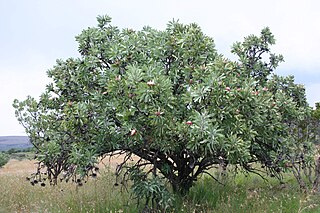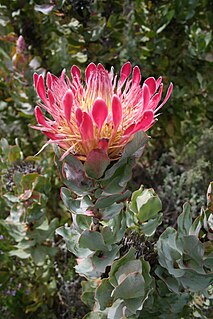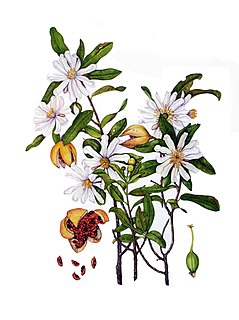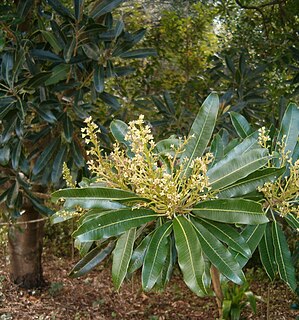
Cussonia is a genus of plants of the family Araliaceae, which is native to the Afrotropics. It originated in Africa and has its center of distribution in South Africa and the Mascarene Islands. Due to their striking habit, they are a conspicuous and easily recognizable group of plants. Their genus name commemorates the botanist Pierre Cusson. The Afro-Malagasy and Asian Schefflera, and Afrotropical Seemannaralia genera are related taxa that share several of its morphological characteristics, among which the leaves borne on the end of branches, inflorescences carried on terminal branches or stems, and reduced leaf complexity in developing inflorescences.

Protea neriifolia, also known as the narrow-leaf sugarbush, oleander-leaved sugarbush, blue sugarbush, or the oleanderleaf protea, is a flowering plant in the genus Protea, which is endemic to South Africa.

Protea caffra, native to South Africa, is a small tree or shrub which occurs in open or wooded grassland, usually on rocky ridges. Its leaves are leathery and hairless. The flower head is solitary or in clusters of 3 or 4 with the involucral bracts a pale red, pink or cream colour. The fruit is a densely hairy nut. The species is highly variable and has several subspecies.

Protea aurea, the long-bud sugarbush, is a shrub or small tree with a single trunk occurring in mountain fynbos, usually on cool, moist, southern slopes. It is endemic to the Cape Provinces of South Africa.

Protea eximia, the broad-leaved sugarbush, is a shrub from South Africa that may become a small tree. It occurs in mountain fynbos on mainly acidic sandy soils; the species was very well known under its old name of Protea latifolia. The flowers have awns that are covered in purple-black velvety hairs, and are contained within a series of rings of involucral bracts that have the appearance of petals. The fruit is a densely hairy nut, many of which are inserted on a woody base. The flowers are borne terminally on long shoots, and have a tendency to become very untidy as they age.

Xylotheca kraussiana is an African shrub or small multi-stemmed tree growing in the sandveld and widely distributed throughout the eastern parts of Southern Africa, in particular the eastern Transvaal, coastal Natal and Mozambique, preferring the sandy soils of coastal bush and forest.

Celtis africana, the white stinkwood, is a deciduous tree in the family Cannabaceae. Its habit ranges from a tall tree in forest to a medium-sized tree in bushveld and open country, and a shrub on rocky soil. It occurs in Yemen and over large parts of Africa south of the Sahara. It is a common tree in the south and east of southern Africa, where the odour given off by freshly-cut green timber is similar to that of Ocotea bullata or Black Stinkwood.

Trichilia emetica is a tree in the family Meliaceae, commonly known as the Natal mahogany. It is an evergreen tree, with handsome glossy dark green leaves and a wide spreading crown. Its sweet-scented flowers attract bees and birds.

Mimusops caffra is a species of tree in family Sapotaceae. This tree is found in coastal dune vegetation in Southern Africa from the Eastern Cape, through KwaZulu-Natal to southern Mozambique.

Deinbollia oblongifolia is a shrub or small tree in the family Sapindaceae. It is commonly known as the dune soap-berry and is found in coastal vegetation from the Eastern Cape of South Africa, through KwaZulu-Natal to southern Mozambique and Swaziland. It is named after Peter Vogelius Deinboll (1783-1876), a Danish botanist and plant collector.

Margaritaria discoidea is a tree in the family Phyllanthaceae, commonly known as the pheasant-berry, egossa red pear or bushveld peacock-berry. These trees are native to the warmer, higher rainfall areas of Africa.

Kiggelaria africana is a large, robust, low-branching African tree, and is currently the only accepted species in the genus Kiggelaria.

Combretum kraussii, the forest bushwillow, is a medium-sized to large tree of eastern South Africa, Eswatini and southern Mozambique, which is found within, or in the vicinity of forests. The specific name commemorates Dr. F. Krauss who undertook a collecting trip to South Africa from 1838 to 1840.

Erythrina zeyheri, commonly known as the ploughbreaker, is a deciduous, geoxylic subshrub and member of the Fabaceae, which is endemic to southern Africa. It grows no more than 60 cm tall and occurs naturally in the higher altitude grasslands of South Africa's central plateau, and that of adjacent Lesotho. They favour deep clay soil in the vicinity of creeks and marshes, and often form colonies. Its specific name commemorates the 19th century botanist, Karl Zeyher.

Cryptocarya woodii, the Cape quince, is a shrub or small forest tree, native to southern and eastern Africa. Its Latin name commemorates John Medley Wood, a botanist in Natal. From mid summer the tree bears small, inconspicuous flowers. The ripe fruit have a bumpy surface and are shiny, purple-black in colour. When a leaf is viewed against light some minute secretory glands are visible in the vein polygons (areolae). The larvae of Papilio euphranor and Charaxes xiphares breed on the foliage of this tree.

Euclea crispa, commonly known as the blue guarri, is an Afrotropical plant species of the family Ebenaceae. The hardy and evergreen plants may form a dense stand of shrubs, or grow to tree size. It is widespread and common in the interior regions of southern Africa, and occurs northward to the tropics. Though some are present near the South African south and east coasts, they generally occur at middle to high altitudes. It is readily recognizable from its much-branched structure and dull bluish foliage colour. Those bearing lanceolate leaves may however resemble the Wild olive, another common species of the interior plateaus.

Dalbergia armata is a scrambling, deciduous species of legume that is native to subtropical to temperate regions of southeastern Africa. The robust, woody liana or small tree is armed with strong spines on the main stem and branches. It occurs sparsely or commonly in forest, bush, riparian fringes and in wooded ravines. It is sometimes employed as a bonsai subject, and it can be propagated from either seed or cuttings.

Protorhus longifolia, the red beech, is a medium to large, mostly dioecious species of tree in the family Anacardiaceae. It is native to South Africa and Eswatini, where it occurs in well-watered situations from coastal elevations to 1,250 m. The leafy, evergreen trees have rounded crowns and usually grow between 6 and 10 m tall, but regularly taller in forest.
Osyris daruma is a species of plant in the family Santalaceae.

Excoecaria simii, the forest pepper-seed or forest pepper-seed bush, is a species of flowering plant in the family Euphorbiaceae. It is endemic to South Africa, in forests of KwaZulu-Natal and Eastern Cape.























